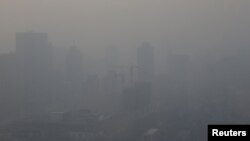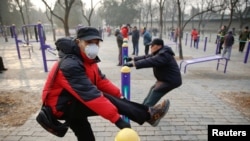A smog-shrouded Chinese city canceled airline flights Sunday because of poor visibility, and parents took children to hospitals on the second day of a pollution alert across the country’s north.
The official Xinhua News Agency said 35 flights in Tianjin, east of Beijing, were delayed or canceled. Highways into the city of 7.5 million people were closed because of extremely low visibility.
Beijing and 22 other Chinese cities imposed emergency measures Saturday, including ordering cars off the road and telling factories and schools to close, after pollution soared to more than 10 times safe levels.
Children hospitalized
On Sunday, news website said the number of children being taken to Beijing hospitals with breathing trouble soared. Photos showed waiting rooms crowded with parents carrying children who wore face masks.
Chinese cities are notorious for noxious air blamed on emissions from older cars and trucks, coal-fired power plants and factories.
Members of the public closely watch levels of PM2.5, particles measuring 2.5 microns across that are easily inhaled and damage lung tissue.
The alert, this winter’s first, lasts through Wednesday. The National Meteorological Center said pollution in a densely populated swath stretching from the country’s northeast across Beijing to eastern China was likely to worsen Monday.
Visibility in some areas was as little as 1,000 meters (3,280 feet), according to the weather agency.
City ‘basically disappeared’
Authorities in Jinan, south of Tianjin, raised that city’s alert to the second-highest level Sunday after the city “basically disappeared” in the haze, the newspaper Jilu Evening News reported. Photos on its website showed downtown office towers as ghostly silhouettes at midday.
Beijing and other cities have tried to improve air quality by switching power plants from coal to natural gas and rolling out fleets of electric buses and taxis.
The Beijing city weather bureau says that despite the latest spike, air in the Chinese capital has improved. It says days on which was it was rated good in the first half of the year increased by 19 to 107, while the number of heavily polluted days fell by two to 14.









